Guys. Great news:
The title of today’s recipe translates to…wait for it…
“Leap into the mouth.”
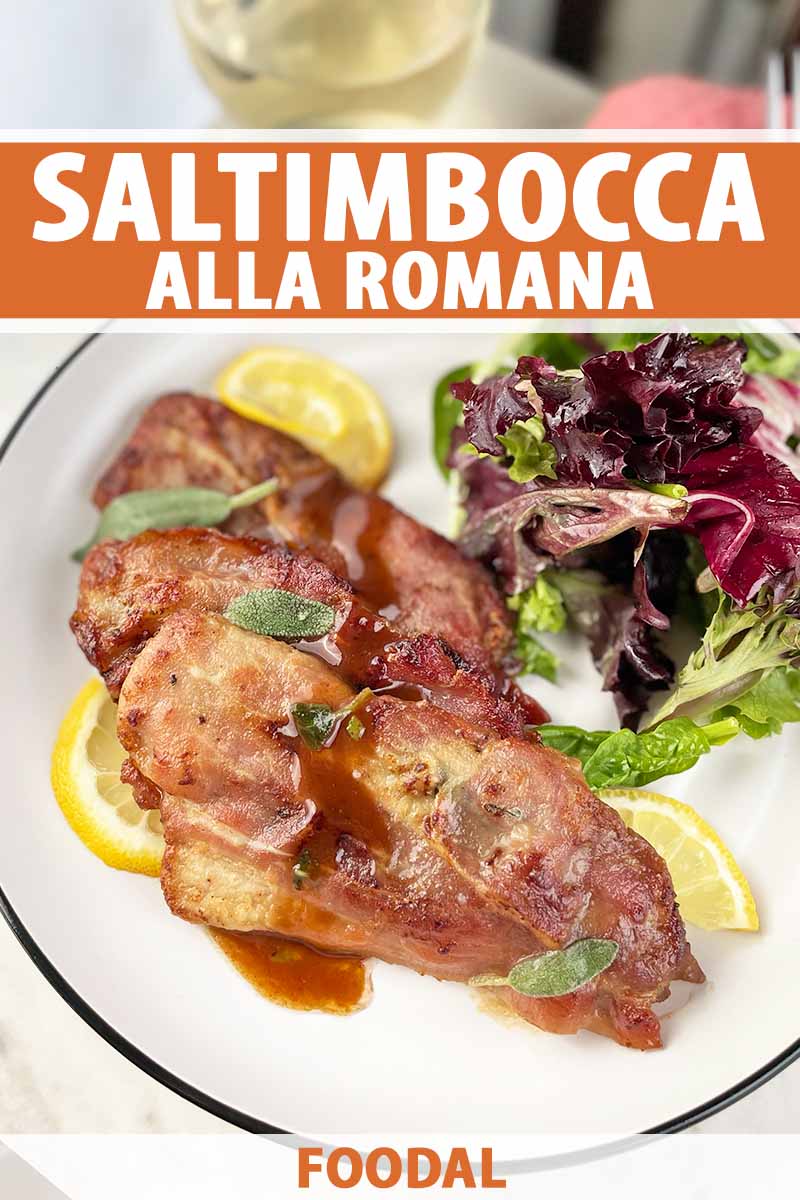
Before unearthing this fascinating fact, I planned on starting things off by saying, “Go on, tell me about something that’s more exciting than the concept of wrapping meat in more meat.” But once I realized that the literal meaning of the name of this Italian dish parallels how insanely delicious it is – well, we’ve hit peak amusement.
And we’re just getting started.
If this hasn’t fully clicked for you yet, this would be like discovering that the word queso translates directly to “land on chips and dive into belly.” Okay, maybe that’s not exactly the same thing… but the point is that this easy Roman feast has plenty of flavor, comes together in no time at all, and ultimately – promises and delivers a dish that’s so good, it jumps on your tongue.
Yay for tongue jumping!
Are you familiar with veal? Here’s my story with the lean meat.
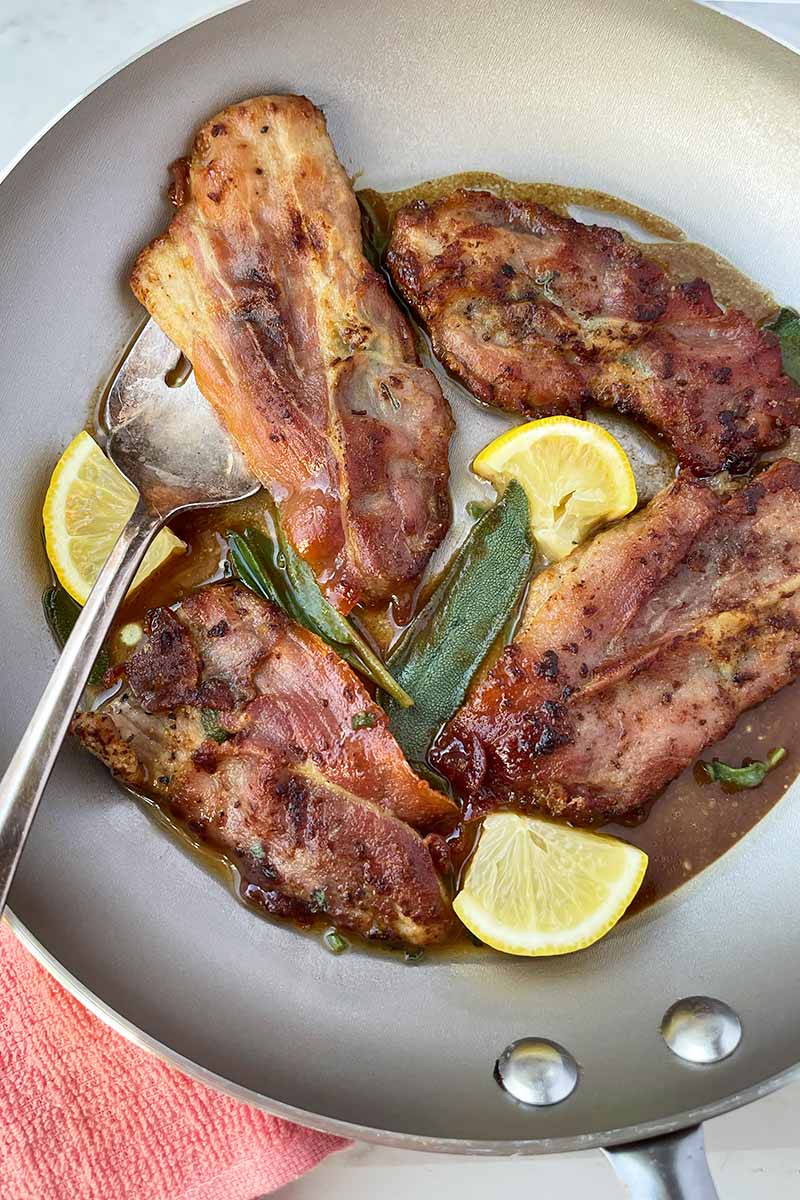
When my parents and sister and I would fly to New Jersey to visit my grandparents, our first dinner stop was always the same. An old-school Italian tavern a town or two over in Summit. My grandparents were loyal customers of Marco Polo for decades, so we always got a warm welcome and a quick table.
Marco Polo was habitually our kickoff setting for the trip, so various uncles, aunts, and cousins (who all resided in nearby burgs) would join in on the marinara-infused merriment.
We each had our regular orders, and it was my Uncle Mitch’s go-to meal that intrigued me the most. While many of us would opt for baked ziti, chicken marsala, or some form of cheesy eggplant, he would proudly partake in veal parmesan.
I spent many Marco Polo outings contemplating asking him for a taste. Slaters participate in the practice of “splitsies” when it comes to sit-down meals, but Mitch eats fast so I often missed my opportunity.
During one particular dinner, I made it my mission to snag a bite before he could wolf down every beautifully battered, red sauce-slathered cutlet and join the clean plate club. The veal was lean, yet juicy and took to its crispy coating beautifully, like the two elements of the dish were meant to be together all along.
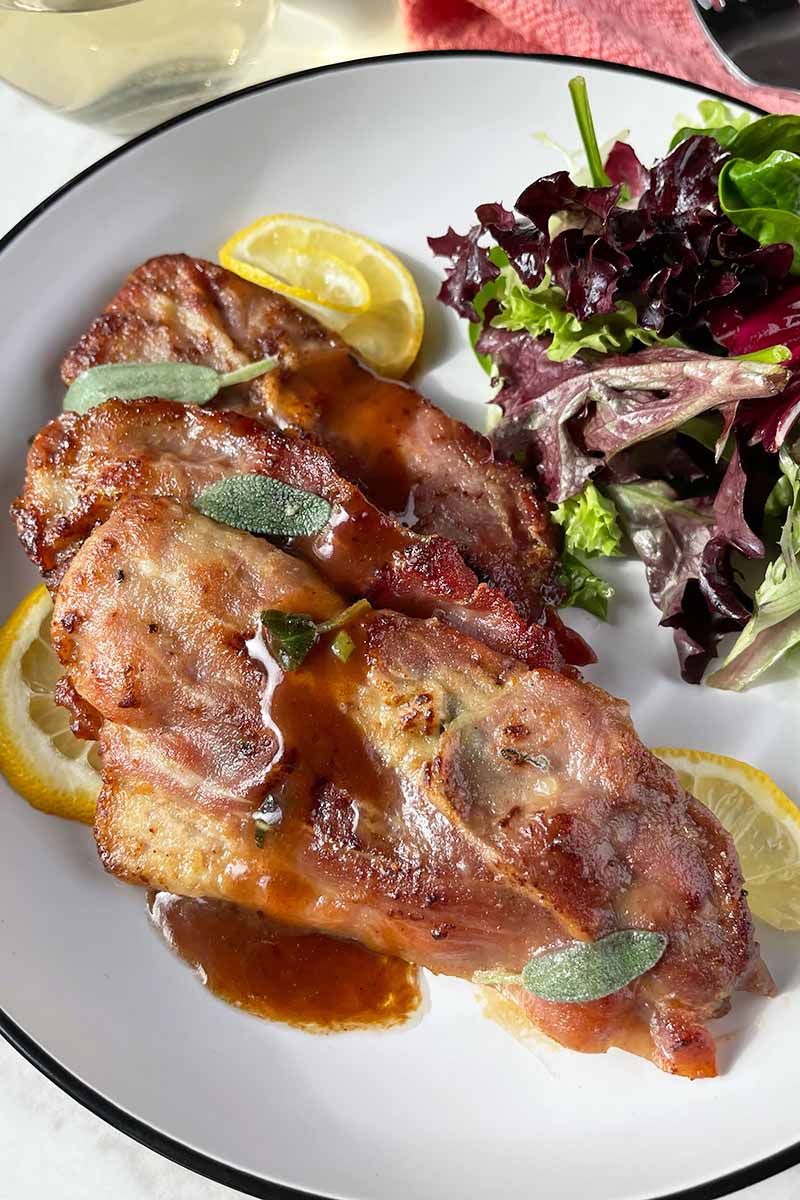
That’s the thing about veal. Its delicate, neutral flavor is practically crying out for a few other fabulous elements to accompany it. That being said, the Romans sure knew what they were doing when they manifested the sensational notion of saltimbocca back in the 19th century.
We’ve already covered how much fun the literal translation of saltimbocca is, but let’s talk about the dish itself. In culinary terms, saltimbocca is veal (or sometimes poultry) rolled with herbs and cured Italian ham.
Keep in mind, though, that rolling the three ingredients together as part of the construction isn’t a requirement.
Assembly-wise, many prefer to lay the veal flat and layer on the sage and prosciutto. This is my method of choice as you’ll see in this recipe. Some top the veal with the prosciutto first, then hold the sage in place with toothpicks, so it’s the first component of the dish to hit the pan.
Fried sage is pretty rad. Can’t deny that.
As for me, I’ve found that sandwiching the sage between both meats produces a finished product that’s the best of both worlds, and I garnish the dish with plenty of additional fresh sage as well. I don’t want its verdant color and musky notes to get lost, after all.
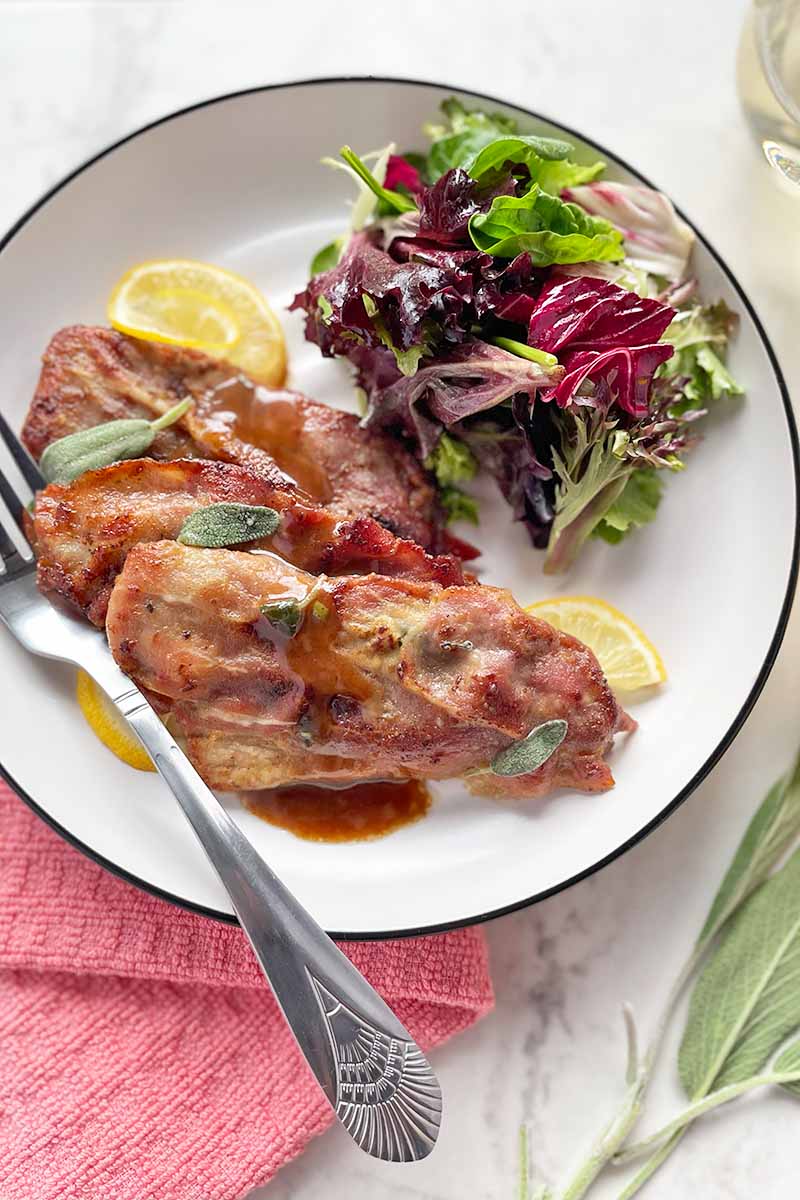
As far as flour goes, some dredge and some don’t.
I personally dig a little bit of breading on the outside of the veal. It’s not a crumb coating, but dredging in flour serves to provide a little texture. You can’t go wrong with a bit of extra crunch, and the texture brings me back to those memories of shared plates with my uncle at Marco Polo.
Additionally, when you remove the finished cutlets from the oil and butter duo that’s coating the hot pan, the residual flour and bits of flavor they leave behind add to the depth of the sauce. A little more butter, a few spritzes of fresh lemon juice to cut through the fat and salt, and your masterpiece is complete.
If that doesn’t scream “leap into the mouth” for you, you might want to get your taste buds checked.
Print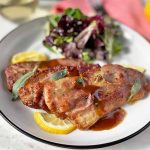
Saltimbocca alla Romana
- Total Time: 30 minutes
- Yield: 4 servings 1x
Description
In this mouthwatering veal saltimbocca, tender cutlets are draped in prosciutto with earthy sage, and delicately fried until golden-brown.
Ingredients
- 8 thin veal cutlets (approximately 2 ounces each)
- 1 teaspoon freshly ground black pepper
- 8 large, thin slices prosciutto (about 4 ounces total)
- 16 medium-size fresh sage leaves (plus more for garnish)
- 1/2 cup all-purpose flour
- 2 tablespoons butter, divided
- 2 tablespoons olive oil
- 1/2 cup Marsala wine (or dry white wine)
- Coarse salt, to taste
- Lemon wedges, for serving
Instructions
- Arrange the veal cutlets on a work surface with a sheet of plastic wrap under them and another on top. Using a meat mallet, pound gently (making sure not to tear the meat) until each piece is about 1/4 inch thick.
- Season the cutlets (either on one side or all over) with the pepper and then lay them back out flat on the bottom piece of plastic wrap. Top each with 2 sage leaves and 1 slice of the prosciutto, gently pressing the prosciutto against the veal to adhere, and folding any excess around the other side. Cover with the other piece of plastic wrap and gently pound the prosciutto into the veal so it sticks and holds down the sage.
- Place the flour on a large plate. Delicately dredge both sides of the veal cutlets, shaking to remove any excess flour, and then set aside.
- In a large skillet over medium heat, add 1 tablespoon of the butter and the olive oil. Once the butter begins to sizzle and turn slightly golden, add the cutlets to the pan (prosciutto-side down) a few at a time, and fry in batches until the prosciutto is crisp and the floured side is lightly browned, about 1 minute per side.
- Transfer the cooked pieces to a plate and cover with foil to keep warm. Pour the wine into the pan, scraping up any brown bits from the bottom, and simmer until reduced by half its volume, about 30-45 seconds. Sprinkle with a pinch of salt and whisk in the remaining butter until the sauce is rich and glossy.
- Arrange the cutlets on a platter prosciutto-side up, pour the sauce over the top, garnish with the remaining fresh sage leaves to taste, and serve with lemon wedges.
- Prep Time: 20 minutes
- Cook Time: 10 minutes
- Category: Veal
- Method: Stovetop
- Cuisine: Meat
Keywords: saltimbocca, veal, meat, Italian, prosciutto, sage
Cooking By the Numbers…
Step 1 – Gather your Ingredients and Pound the Veal
On a work surface like a spacious countertop or cutting board, lay out one large piece of plastic wrap. Arrange the veal cutlets on top of the plastic wrap and then cover them with another piece that’s the same size.
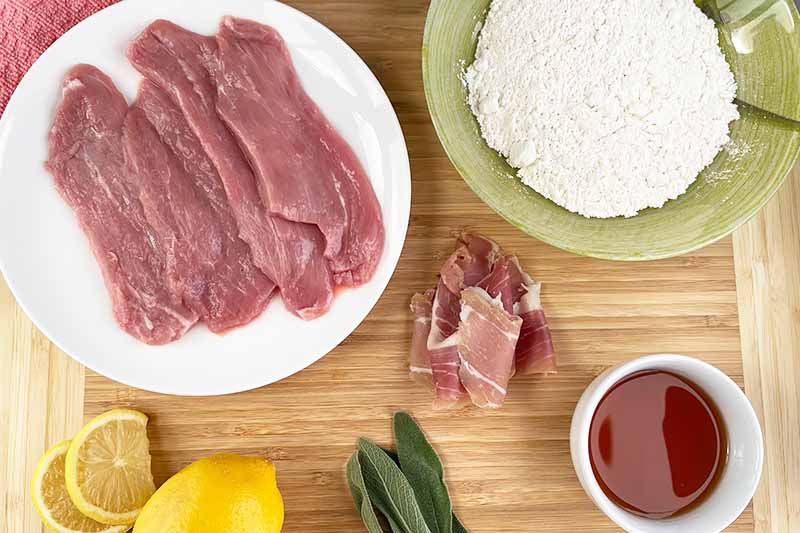
Using something heavy like a meat mallet, rolling pin, or a heavy-bottomed cast iron pan, gently pound and flatten the cutlets so they’re all the same thickness, about 1/4 inch.
You want to do this somewhat delicately to make sure you don’t tear the meat. If your veal pieces came as “cutlets,” they’re likely already very thin and only need to be pounded until they’re all the same thickness, so they cook evenly.
Set aside the top piece of plastic wrap since you’ll be using it again.
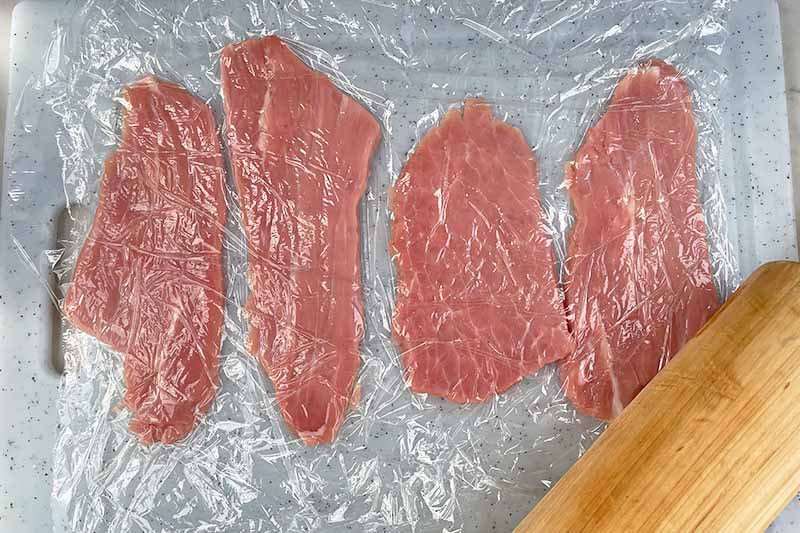
Season either one or both sides of the cutlets with the pepper. If you plan to season both sides, do this before you layer on the sage and prosciutto. I prefer to only season the bare side, so the side with the herbs and meat isn’t discolored with black specks. This is totally up to you.
Keep in mind that you don’t need to season the veal with salt because the prosciutto is already very salty.
Step 2 – Layer the Sage and Prosciutto
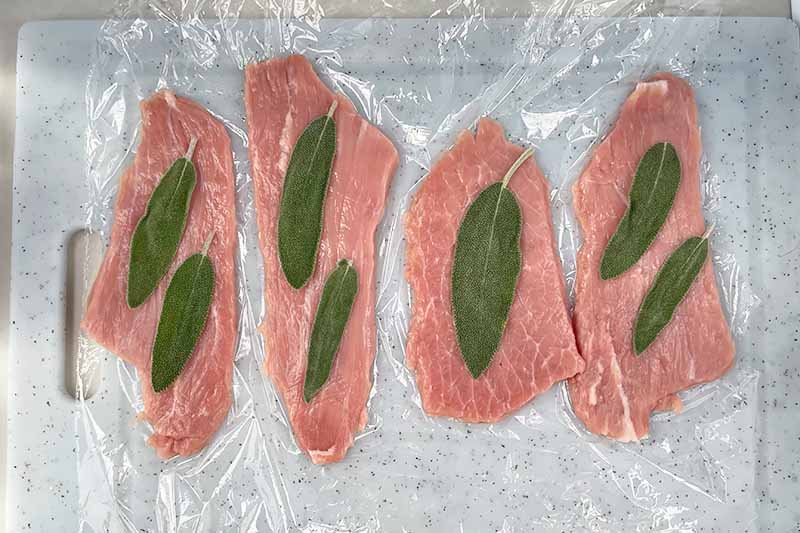
Top each cutlet with 2 of the sage leaves. If you’re working with large leaves, you can place just one in the middle, but if your herbs are more on the small to medium side, use 2 per piece of veal.

Top the sage with a slice of prosciutto, gently pressing it against the veal to adhere, and folding any excess around the other side.
Step 3 – Pound in the Prosciutto and Flour the Veal
Many recipes call for toothpicks to keep the prosciutto in place, and this works well if you want the sage to be on the outside. Since the prosciutto is holding down the sage here, you don’t need toothpicks!
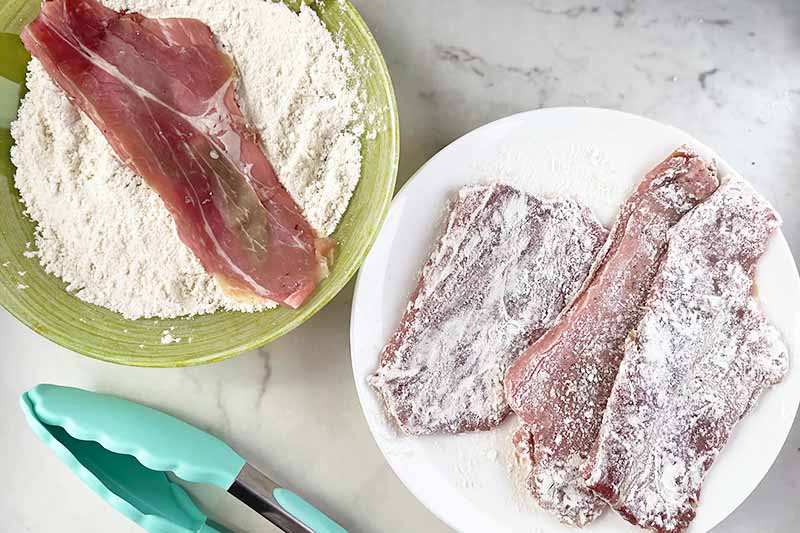
Re-cover the cutlets with the top piece of plastic wrap and gently pound the prosciutto into each cutlet. This will help to ensure that it sticks perfectly.
Place the flour in a large shallow bowl or plate and have an empty plate ready for the floured cutlets. You could use cornstarch instead of flour if you prefer to go with a gluten-free option, and this will result in a thicker sauce.
Seasoning the flour isn’t necessary since the veal is seasoned with pepper and the prosciutto is already salted, but feel free to stir in a few pinches of S&P if you like.
Using tongs, delicately dredge both sides of the veal cutlets in the flour. Give each one a gentle shake to remove any excess flour and then set them aside on the plate.
Step 4 – Fry the Veal
In a large skillet over medium heat, add 1 tablespoon of the butter and the olive oil. Once the butter begins to sizzle and turn slightly golden, add the cutlets to the pan a few at a time, prosciutto-side down.
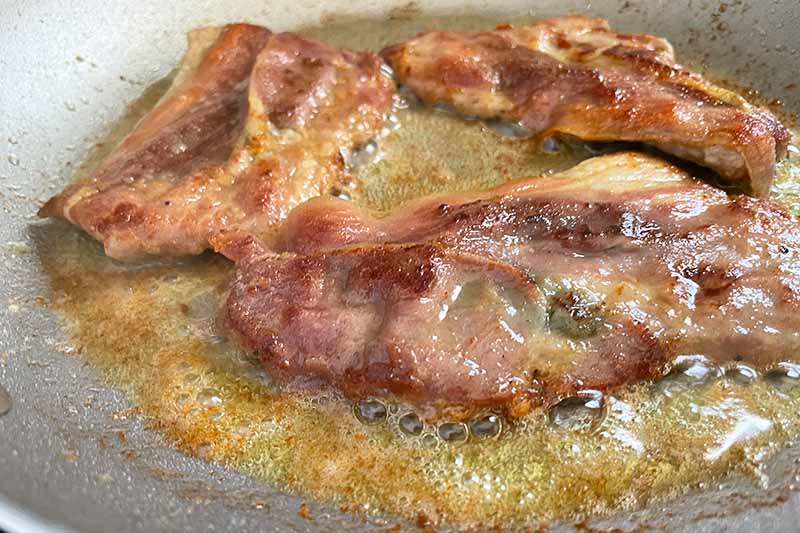
It doesn’t necessarily make a big difference which side you cook first, but I think that crisping up the prosciutto side first adds a little salty flavor and fat to the pan.
You want to fry the veal in batches to avoid overcrowding the pan, which would lower the temperature of the oil and lead to steaming and uneven cooking.
Fry for about 1 minute per side, or until the prosciutto side is crisp and the floured side is lightly browned. Veal will become tough if it’s overcooked, and it will cook quickly because it’s so thin.
Transfer the cooked pieces to a clean plate or serving platter prosciutto-side up, and cover with foil to keep them warm while you fry the next batch.
Step 5 – Make the Sauce and Serve
Slice the lemon wedges for the garnish. You can also chop some of the remaining sage for garnish, or decorate the platter with whole leaves.
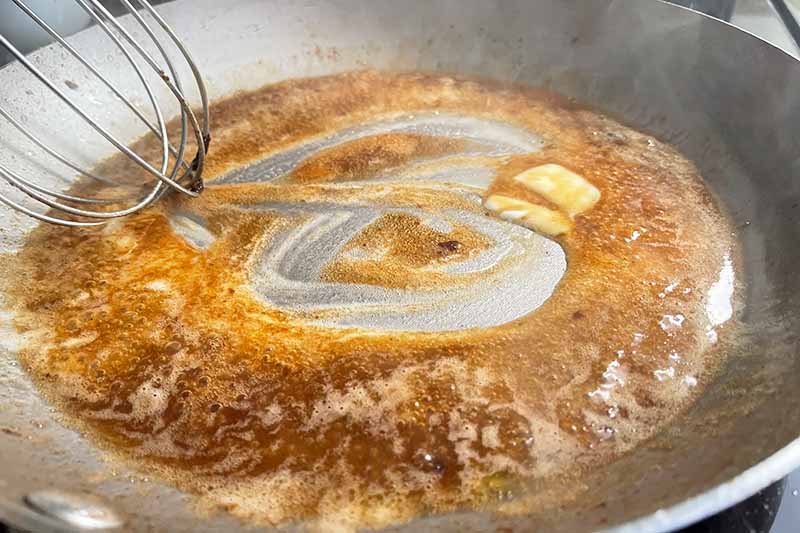
Deglaze the pan by adding the wine, and scraping any brown bits from the bottom as you pour. Simmer and allow the wine to reduce by about half. This should take about 30 to 45 seconds.
Sprinkle with a pinch of salt, and whisk in the remaining butter until the sauce is rich and glossy. If the sauce seems too thick, a few splashes of hot chicken or vegetable stock or water will thin it out.

Pour the sauce over the cutlets, garnish with sage, and serve with the lemon wedges.
Meat on Herbs on Meat
Although this meal is about as weeknight-friendly as it gets, I won’t lie to you and say that veal should always be your go-to protein for a saltimbocca-style preparation. Veal has a higher price tag than standard beef, chicken, or pork – but that also makes it a bit more of a delicacy.

It’s lean, tender, and simple to work with, but if you have trouble tracking it down, substituting chicken cutlets is completely acceptable. The magic is really in the Marsala sauce.
Actually, those bold, herbal sage leaves make quite an impact on the palate too. And that salty, buttery prosciutto that crisps into submission? Dang.
Maybe the magic is everywhere.
A light, fresh mixed greens salad served alongside this meal cuts through the richness. Though I strongly recommend a starch for soaking up any extra sauce.
Potatoes? Polenta? How will you make sure you don’t miss a drop? Share your side dish ideas in the comments below! And don’t forget to give this recipe a five-star rating if you loved it.
If an easy yet decadent feast featuring beef sounds like comfort food at its finest, you’ll fall in love with these radiant recipes as well:
Photos by Fanny Slater, © Ask the Experts, LLC. ALL RIGHTS RESERVED. See our TOS for more details. Originally published by Nina-Kristin Isensee on July 20, 2015. Last updated on February 28, 2022.
Nutritional information derived from a database of known generic and branded foods and ingredients and was not compiled by a registered dietitian or submitted for lab testing. It should be viewed as an approximation.
About Fanny Slater
Fanny Slater is a home-taught food enthusiast based in Wilmington, North Carolina who won the “Rachael Ray Show” Great American Cookbook Competition in 2014, and published her cookbook “Orange, Lavender & Figs” in 2016. Fanny is a food and beverage writer, recipe developer, and social media influencer. She was a co-host on the Food Network series “Kitchen Sink,” was featured on Cooking Channel’s longtime popular series “The Best Thing I Ever Ate,” and continues to appear regularly on the “Rachael Ray Show.”

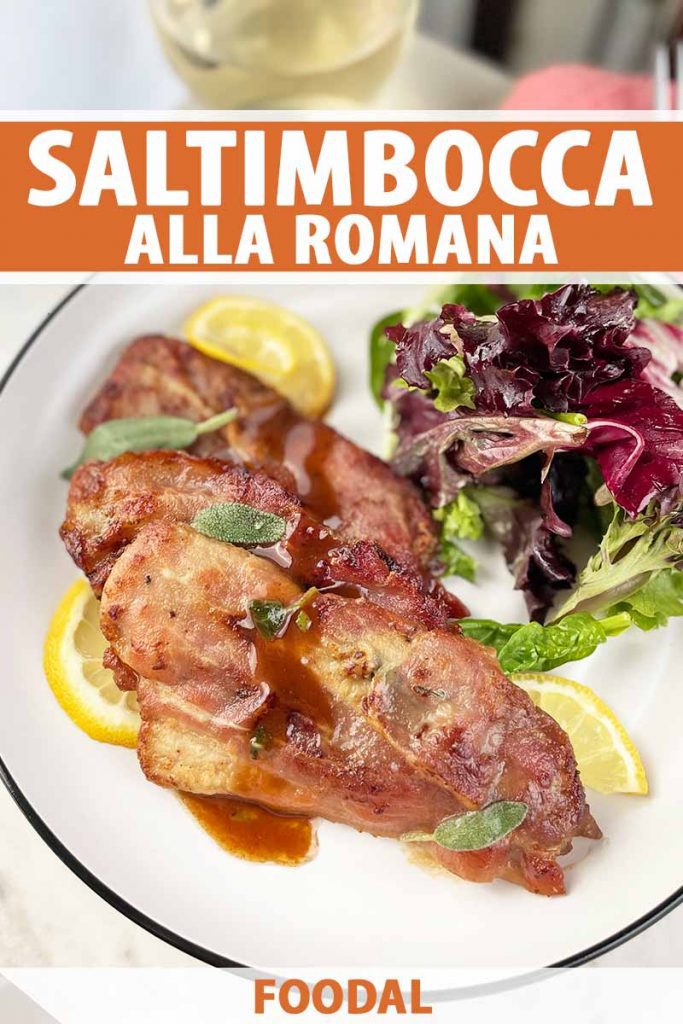
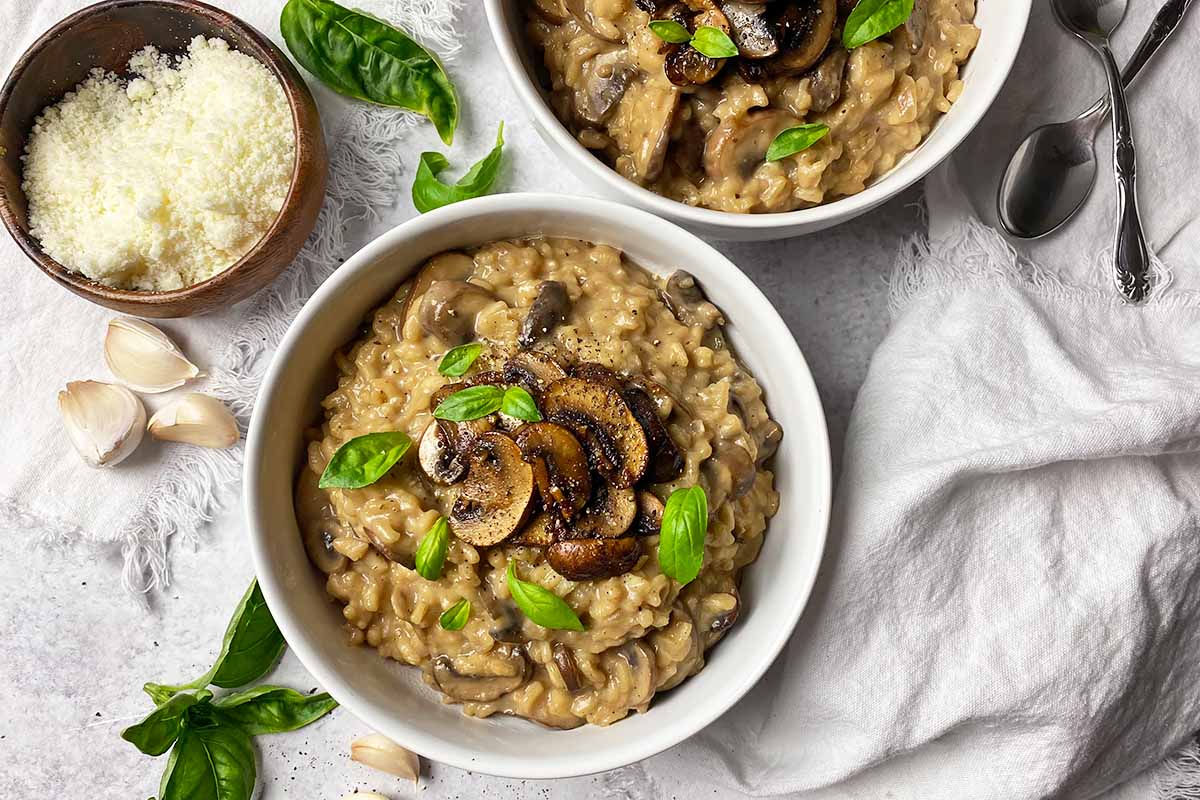
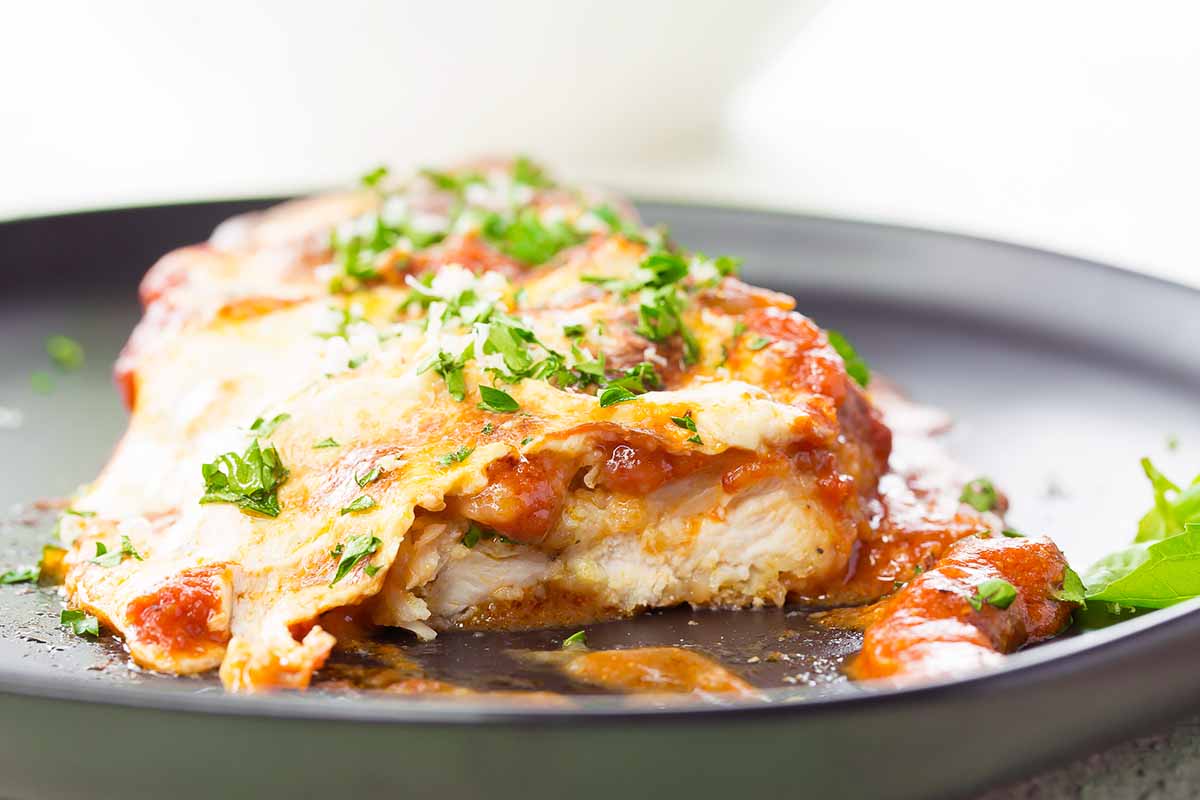
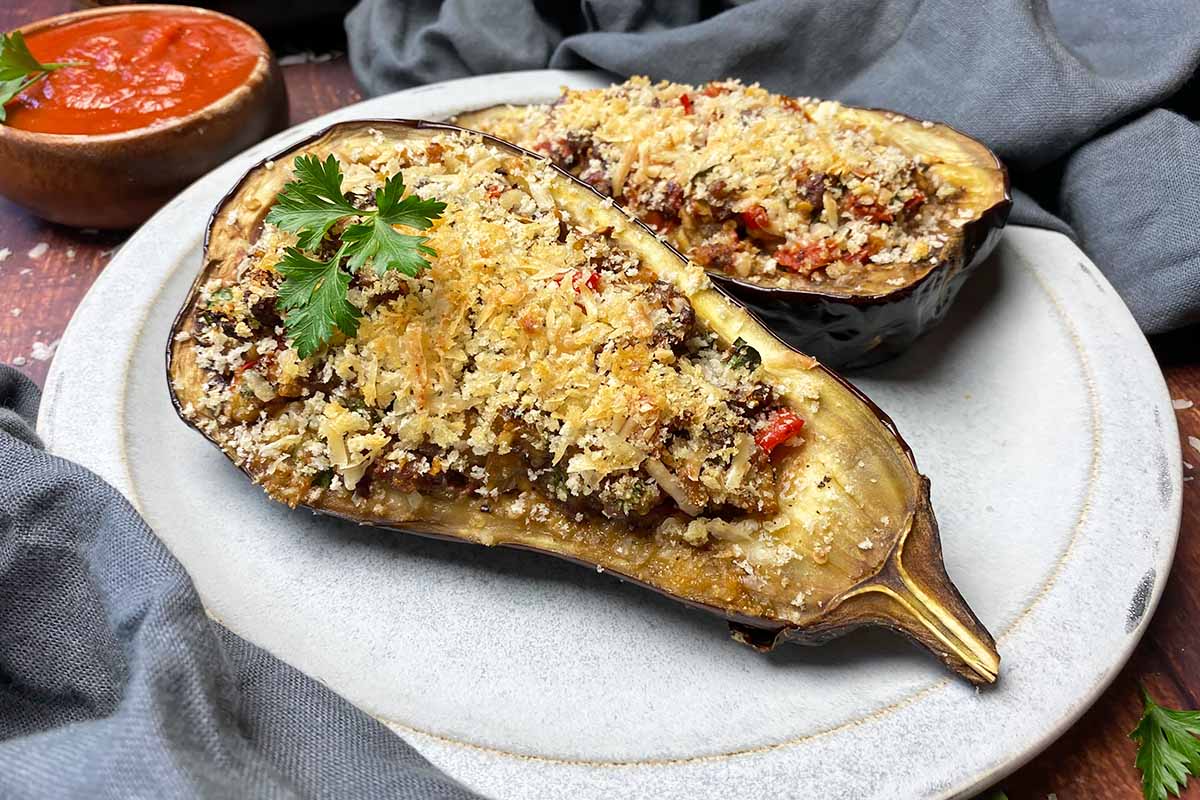
I’ve heard of Saltimbocca over the years, but never knew exactly what it was. I’ve never eaten much veal, since it’s expensive, and now that I know what it is, I would probably prefer to substitute chicken or fish, but the Prosciutto, sage and butter sound like a wonderful flavor combination. I like the grill suggestion, that’s not something I would have thought of doing with this recipe.
Interesting simple dish. Veal, the baby calf. We’re not going to marinade this one before hand. I guess there is a layer of ham on this in the photo. Yes I see that in the article but not in the recipe. I would imagine that is thinly sliced and just placed over top with the rest.
If you’re looking for the ham in the recipe, it’s the Prosciutto. It is an air-dried type of ham, a nice choice for this kind of meal. If you like, you can replace it with other types, I suggested Serrano or Parma in the article too. It is thinly sliced and sticked to the meat with sage.
If you’re not into veal, use chicken or white fish as a substitution. It tastes as great as the usual combination. I often replace the veal too, but it is part of the original Roman recipe.
I have actually heard of this before as a friend suggested it to me. I typically don’t prefer ham as it tends to verge on too salty for me, although I loved it as a child. It looks like an elegant meal to try to make, though I’m sure I cannot replicate the picture whatsoever. Thank you for the idea, however! I probably would attempt this around Christmas as that is usually when my family has loads of pork. 🙂
I think you are right on this one that sometimes you don’t need a lot of ingredients to make an elegant dish. The dish in the photo looks divine, something I would see on a cooking show.
I’m always happy to see a recipe which includes veal – I’m a real fan of the meat but hardly ever see it for sale here in the UK. I really like the idea of these two fairly unusual meats served together and it’s definitely one to try should I ever come across veal in the store.
I just got home from vacation, and in that trip I had my first taste of veal! I’m practically ignorant of this type of meat, but when I had a taste of it I kind of like it. So, hit the search button and found this recipe. Although I’m yet to find out if this meat is available in my local supermarket, or if I even could afford it, I love the thought that this recipe is simple to make. Anything that is easy to prepare just catches my attention as I’m not pretty savvy in the kitchen, sadly. Nevertheless, that doesn’t stop me from browsing through recipes and imagine that I can make them one day. Anyhow, the pictures just makes me hungry now and oh, the amount of rice I can eat with this dish. Love.
I’m sure you’ll be successful if you try this one! But if you can’t find veal (often difficult for me, too) you could it with other types of meat. Poultry, for example, goes great with this combination. Enjoy this mediterranean nuance 🙂
Well my ears perked up a little bit when I heard Roman, and thought I might get a little nostalgia here. I was in Italy about five years ago, and went to Rome, but I do not remember having anything that resembles this. That said, though, there were certainly some similar dishes, and pretty much every night was a just a platter of different meats, which were delicious. It may not be the exact nostalgia I was thinking, but I bet I can muster some. Thanks for sharing.
This is the best dish. If this is on the menu when I get to a restaurant, I order it. I don’t eat/ cook veal at home so this is special to me.
I have also had it served over a bed of spinach. Enjoy!!
★★★★★